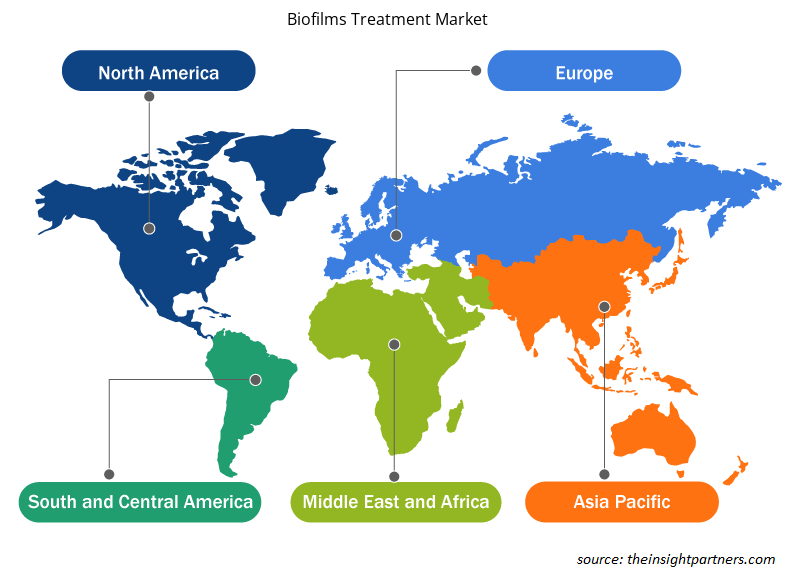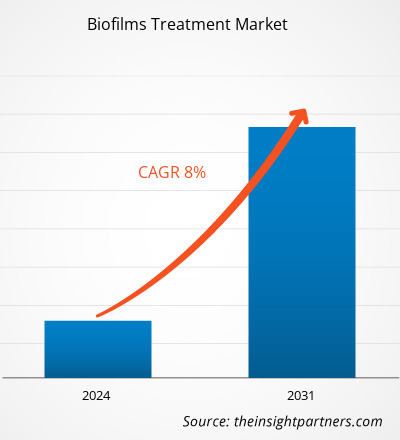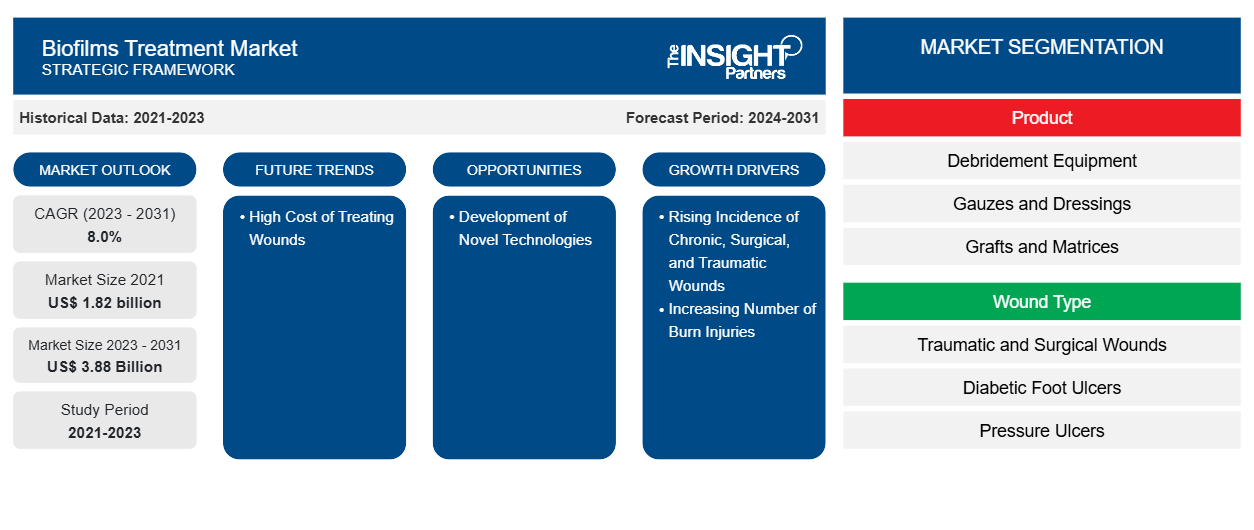El tamaño del mercado de tratamiento de biopelículas en 2021 se situó en 1.820 millones de dólares estadounidenses y se prevé que alcance los 3.880 millones de dólares estadounidenses en 2031, frente a los XX mil millones de dólares estadounidenses de 2023. Se espera que el mercado registre una CAGR del 8,0 % entre 2023 y 2031. Es probable que los crecientes desarrollos estratégicos, como el lanzamiento y la aprobación de productos y el desarrollo de nuevas tecnologías, sigan siendo tendencias clave en el mercado de tratamiento de biopelículas.
Análisis del mercado de tratamiento de biopelículas
La creciente incidencia de heridas e infecciones y la propagación de biopelículas en los dispositivos médicos aumentan la demanda de tratamiento con biopelículas, lo que impulsa el mercado a nivel mundial. Además, la creciente prevalencia de biopelículas es un factor adicional que se espera que aumente el crecimiento del mercado durante el período de pronóstico. Según algunos estudios, las biopelículas están presentes en el 60 al 100% de las muestras de heridas crónicas. Este factor representa la distribución más rápida y espacial de las biopelículas en las heridas crónicas, lo que requeriría un tratamiento óptimo de las biopelículas. Es probable que las mejoras tecnológicas, el desarrollo de nuevos productos y la entrada de nuevos actores en el tratamiento con biopelículas expandan el mercado a nivel mundial. Factores como el aumento de las infecciones relacionadas con las biopelículas y la resistencia a los antibióticos, así como el alto costo y la baja adopción de productos avanzados para el cuidado de heridas, también son restricciones potenciales que obstaculizan el crecimiento general del mercado mundial de tratamiento con biopelículas.
Descripción general del mercado de tratamiento de biopelículas
El aumento de los gastos sanitarios, el envejecimiento de la población, que es más propensa a sufrir heridas crónicas, el lanzamiento de nuevos productos y los escenarios de reembolso favorables impulsan el crecimiento del mercado. Las autoridades reguladoras reconocen cada vez más el impacto de las infecciones relacionadas con las biopelículas en la salud pública. Se están desarrollando normas y directrices estrictas para prevenir y tratar las infecciones relacionadas con las biopelículas, lo que aumenta la demanda de soluciones de tratamiento de biopelículas que cumplan con las normas. Las empresas buscan activamente avances tecnológicos e innovaciones para mejorar el tratamiento de las biopelículas más allá de los métodos tradicionales. Estas innovaciones pueden incluir el desarrollo de apósitos avanzados para heridas con propiedades antimicrobianas mejoradas, la integración de materiales inteligentes para detectar y combatir las biopelículas y la exploración de sistemas de administración de fármacos dirigidos para responder a las bacterias incrustadas en las biopelículas. Además, se están realizando esfuerzos de investigación para utilizar nuevas tecnologías, como la biotecnología y la nanotecnología, para desarrollar soluciones más efectivas y eficientes para el tratamiento de las biopelículas.
Personalice este informe según sus necesidades
Obtendrá personalización en cualquier informe, sin cargo, incluidas partes de este informe o análisis a nivel de país, paquete de datos de Excel, así como también grandes ofertas y descuentos para empresas emergentes y universidades.
- Obtenga las principales tendencias clave del mercado de este informe.Esta muestra GRATUITA incluirá análisis de datos, desde tendencias del mercado hasta estimaciones y pronósticos.
Factores impulsores y oportunidades del mercado del tratamiento de biopelículas
Aumento de la incidencia de heridas crónicas, quirúrgicas y traumáticas favorece al mercado
Según el estudio de la Federación Internacional de Diabetes (Estimaciones de prevalencia de diabetes a nivel mundial y regional para 2019 y proyecciones para 2030 y 2045), la prevalencia de diabetes en 2019 fue de alrededor del 9,3 %, es decir, alrededor de 463 millones de personas. Se espera que alcance el 10,2 %, es decir, alrededor de 578 millones, para 2030. Las biopelículas también afectan significativamente a los pulmones y los sistemas digestivos de los pacientes con fibrosis quística (FQ). Más de 70 000 personas viven con FQ en todo el mundo, de las cuales alrededor de 30 000 viven en los EE. UU. Las biopelículas en el pulmón con FQ son altamente resistentes al tratamiento con antibióticos . Contribuyen significativamente al impacto económico general de la FQ, que asciende a unos 7509 millones de dólares estadounidenses por año en todo el mundo. Además, las tecnologías médicas avanzadas han llevado a un aumento en el número de cirugías. Según el Sistema Nacional de Vigilancia de Infecciones Nosocomiales, anualmente se realizan aproximadamente 27 millones de procedimientos quirúrgicos en los EE. UU., de los cuales, alrededor del 5 % resultan en infecciones del sitio quirúrgico.
Aumento de la investigación en las economías emergentes: una oportunidad para el crecimiento del mercado del tratamiento de biopelículas
La creciente conciencia sobre la importancia de las biopelículas microbianas en diversos sectores continúa revelando nuevas oportunidades para el desarrollo de tecnologías innovadoras en la investigación traslacional que puedan abordar sus efectos nocivos y aprovechar sus beneficios. La investigación en curso se centra en el desarrollo de nuevos compuestos que se puedan utilizar con antibióticos para combatir infecciones. Se requieren estrategias avanzadas o enfoques innovadores para prevenir y erradicar infecciones clínicamente importantes, especialmente a escala nanométrica. Comprender cómo las biopelículas promueven la infección y la resistencia a los antibióticos es fundamental para desarrollar enfoques efectivos para tratar las infecciones causadas por patógenos nosocomiales. La síntesis de nanomateriales multifuncionales avanzados que permitan simultáneamente el diagnóstico y la terapia se ha convertido en un área de gran interés en la investigación contemporánea. Los avances en transcriptómica, metabolómica y secuenciación de próxima generación basada en transposones pueden revelar nuevos objetivos genéticos para la investigación de biopelículas.
Mientras tanto, se deben descubrir nuevos agentes antibiofilm que se dirijan a los componentes bacterianos específicos del biofilm. Los agentes antibiofilm basados en nanopartículas representan un área emergente de investigación que ha mostrado resultados prometedores en la lucha contra los biofilms bacterianos, en particular cuando se utilizan múltiples agentes. En abril de 2021, MSU amplió sus capacidades de investigación de biofilms con una subvención de 513.000 dólares estadounidenses del Murdock Trust. Por lo tanto, se espera que los estudios e investigaciones en curso tengan un impacto positivo en el tratamiento de los biofilms, brindando así oportunidades lucrativas para el crecimiento del mercado.
Análisis de segmentación del informe de mercado de tratamiento de biopelículas
Los segmentos clave que contribuyeron a la derivación del análisis del mercado de tratamiento de biopelículas son el producto, el tipo de herida y el usuario final.
- Según el producto, el mercado de tratamiento de biopelículas se divide en equipos de desbridamiento, gasas y apósitos, injertos y matrices, entre otros. El segmento de gasas y apósitos tuvo la mayor participación del mercado en 2023 y se prevé que el mismo segmento registre la CAGR más alta durante el período de pronóstico.gauzes and dressings, grafts and matrices, and others. The gauzes and dressings segment held the largest share of the market in 2023 and the same segment is anticipated to register the highest CAGR during the forecast period.
- Por tipo de herida, el mercado está segmentado en heridas traumáticas y quirúrgicas, úlceras del pie diabético, úlceras por presión, úlceras venosas de las piernas y otras heridas. El segmento de heridas traumáticas y quirúrgicas tuvo la mayor participación del mercado en 2023, y se prevé que el mismo segmento registre la CAGR más alta durante 2023-2031.CAGR during 2023–2031.
- En términos de usuario final, el mercado está segmentado en hospitales, entornos de atención domiciliaria y otros usuarios finales. El segmento de hospitales tuvo la mayor participación del mercado en 2023. Además, se estima que el mismo segmento registrará la CAGR más alta durante el período de pronóstico.CAGR during the forecast period.
Análisis de la cuota de mercado del tratamiento de biopelículas por geografía
El alcance geográfico del informe de mercado de tratamiento de biopelículas se divide principalmente en cinco regiones: América del Norte, Asia Pacífico, Europa, Medio Oriente y África, y América del Sur / América del Sur y Central.
El mercado de tratamiento de biopelículas ha sido dominado por América del Norte. El crecimiento del mercado en América del Norte se atribuye al aumento de la prevalencia de la diabetes, así como a la presencia de asociaciones que ofrecen soluciones para el cuidado de heridas. En América del Norte, el sector de la biotecnología desempeña un papel importante en el desarrollo del tratamiento de biopelículas. Se reconoce que la diabetes mellitus (DM) tiene una prevalencia epidémica en los EE. UU. en comparación con la incidencia de la enfermedad en todo el mundo. Con un aumento en el número de pacientes diabéticos, también se prevé un aumento de las complicaciones asociadas. Varias organizaciones y revistas han publicado prácticas preferidas para curar y cerrar las úlceras del pie diabético. Sin embargo, a pesar de las pautas sugeridas, solo el 50% de las úlceras del pie diabético se recuperan en un año en los EE. UU. Wounds Canada, anteriormente conocida como la Asociación Canadiense de Cuidado de Heridas , es una organización sin fines de lucro que trabaja para el avance de la prevención y el tratamiento de heridas en Canadá. La organización se centra principalmente en cuatro áreas clave: educación, investigación, defensa y concienciación, y asociaciones. Asociación Mexicana para el Cuidado y Curación de Heridas, organización civil sin fines de lucro, integrada por un grupo multidisciplinario de especialistas dedicados al estudio de heridas y estomas en México. La asociación promueve la atención integral y el acceso a tratamientos de heridas y estomas, con la ayuda del personal de salud, para mejorar la calidad de vida del paciente. Se prevé que Asia Pacífico crezca con la CAGR más alta en los próximos años. CAGR in the coming years.
Perspectivas regionales del mercado de tratamiento de biopelículas
Los analistas de Insight Partners explicaron en detalle las tendencias y los factores regionales que influyen en el mercado de tratamiento de biopelículas durante el período de pronóstico. Esta sección también analiza los segmentos y la geografía del mercado de tratamiento de biopelículas en América del Norte, Europa, Asia Pacífico, Oriente Medio y África, y América del Sur y Central.

- Obtenga datos regionales específicos para el mercado de tratamiento de biopelículas
Alcance del informe de mercado sobre tratamiento de biopelículas
| Atributo del informe | Detalles |
|---|---|
| Tamaño del mercado en 2021 | 1.820 millones de dólares estadounidenses |
| Tamaño del mercado en 2031 | 3.880 millones de dólares estadounidenses |
| CAGR global (2023 - 2031) | 8.0% |
| Datos históricos | 2021-2023 |
| Período de pronóstico | 2024-2031 |
| Segmentos cubiertos | Por producto
|
| Regiones y países cubiertos | América del norte
|
| Líderes del mercado y perfiles de empresas clave |
|
Densidad de actores del mercado de tratamiento de biopelículas: comprensión de su impacto en la dinámica empresarial
El mercado de tratamiento de biopelículas está creciendo rápidamente, impulsado por la creciente demanda de los usuarios finales debido a factores como la evolución de las preferencias de los consumidores, los avances tecnológicos y una mayor conciencia de los beneficios del producto. A medida que aumenta la demanda, las empresas amplían sus ofertas, innovan para satisfacer las necesidades de los consumidores y aprovechan las tendencias emergentes, lo que impulsa aún más el crecimiento del mercado.
La densidad de actores del mercado se refiere a la distribución de las empresas o firmas que operan dentro de un mercado o industria en particular. Indica cuántos competidores (actores del mercado) están presentes en un espacio de mercado determinado en relación con su tamaño o valor total de mercado.
Las principales empresas que operan en el mercado de tratamiento de biopelículas son:
- Grupo Mimedx Inc.,
- Grupo Convatec Plc,
- Coloplast A/S,
- Mlnlycke Healthcare AB,
- Organogénesis Holdings Inc.,
- Corporación Integra Lifesciences Holdings,
Descargo de responsabilidad : Las empresas enumeradas anteriormente no están clasificadas en ningún orden particular.

- Obtenga una descripción general de los principales actores clave del mercado de tratamiento de biopelículas
Noticias y desarrollos recientes del mercado de tratamiento de biopelículas
El mercado de tratamiento de biopelículas se evalúa mediante la recopilación de datos cualitativos y cuantitativos posteriores a la investigación primaria y secundaria, que incluye publicaciones corporativas importantes, datos de asociaciones y bases de datos. A continuación, se incluye una lista de los avances en el mercado de tratamiento de biopelículas:
- La Fundación para la Fibrosis Quística invirtió hasta 5 millones de dólares en Clarametyx Biosciences para desarrollar CMTX-101, un fármaco que podría ayudar a combatir bacterias difíciles de tratar, como la Pseudomonas aeruginosa crónica, una de las principales causas de infecciones pulmonares en personas con fibrosis quística. (Fundación para la Fibrosis Quística, Noticias, 2024)
- Trellis Bioscience Inc., una empresa de biotecnología pionera centrada en el descubrimiento y desarrollo de anticuerpos monoclonales humanos nativos, anunció que su principal candidato a anticuerpo, TRL1068, recibió las designaciones Fast Track y QIDP de la Administración de Alimentos y Medicamentos de los Estados Unidos (FDA). (Fuente: Trellis Bioscience, Inc., Noticias, 2024)
- Asep Medical Holdings Inc. anunció el uso de inteligencia artificial (IA) que permitió el desarrollo de tratamientos nuevos y mejorados para infecciones comunes de biopelículas y diagnósticos rápidos de sepsis. (Fuente: ASEP Medical Holdings Inc., Noticias, 2024)
- Medline y OMNIA Partners anunciaron una nueva asociación de compras. El acuerdo ofreció ahorros en los costos de la cartera de productos médico-quirúrgicos a las agencias del sector público. Entre las agencias públicas elegibles, se incluyen los gobiernos estatales, de condado y locales, los sistemas de educación primaria y superior y los servicios de seguridad pública, que podrán acceder a la cartera completa de Medline de más de 300 000 suministros médicos. (Medline Industries, LP, comunicado de prensa, 2022)
Informe de mercado sobre tratamiento de biopelículas: cobertura y resultados
El informe “Tamaño y pronóstico del mercado de tratamiento de biopelículas (2021-2031)” proporciona un análisis detallado del mercado que cubre las siguientes áreas:
- Tamaño del mercado y pronóstico a nivel global, regional y nacional para todos los segmentos clave del mercado cubiertos bajo el alcance
- Dinámica del mercado, como impulsores, restricciones y oportunidades clave
- Principales tendencias futuras
- Análisis detallado de las cinco fuerzas de Porter y PEST y FODA
- Análisis del mercado global y regional que cubre las tendencias clave del mercado, los principales actores, las regulaciones y los desarrollos recientes del mercado.
- Análisis del panorama de la industria y de la competencia que abarca la concentración del mercado, el análisis de mapas de calor, los actores destacados y los desarrollos recientes
- Perfiles detallados de empresas
- Análisis histórico (2 años), año base, pronóstico (7 años) con CAGR
- Análisis PEST y FODA
- Tamaño del mercado, valor/volumen: global, regional y nacional
- Industria y panorama competitivo
- Conjunto de datos de Excel
Informes recientes
Informes relacionados
Testimonios
Razón para comprar
- Toma de decisiones informada
- Comprensión de la dinámica del mercado
- Análisis competitivo
- Información sobre clientes
- Pronósticos del mercado
- Mitigación de riesgos
- Planificación estratégica
- Justificación de la inversión
- Identificación de mercados emergentes
- Mejora de las estrategias de marketing
- Impulso de la eficiencia operativa
- Alineación con las tendencias regulatorias





















 Obtenga una muestra gratuita para - Mercado de tratamiento de biopelículas
Obtenga una muestra gratuita para - Mercado de tratamiento de biopelículas